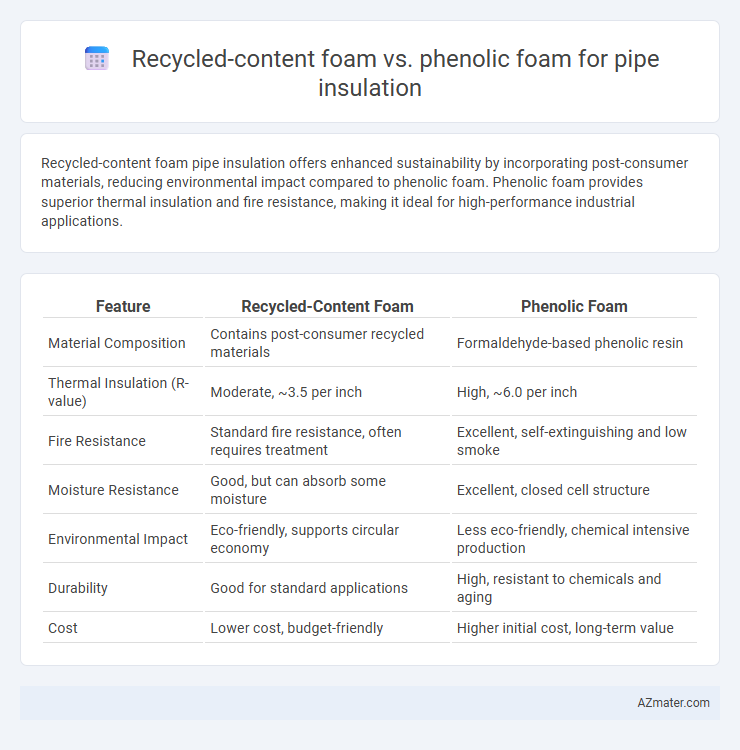Recycled-content foam pipe insulation offers enhanced sustainability by incorporating post-consumer materials, reducing environmental impact compared to phenolic foam. Phenolic foam provides superior thermal insulation and fire resistance, making it ideal for high-performance industrial applications.
Table of Comparison
| Feature | Recycled-Content Foam | Phenolic Foam |
|---|---|---|
| Material Composition | Contains post-consumer recycled materials | Formaldehyde-based phenolic resin |
| Thermal Insulation (R-value) | Moderate, ~3.5 per inch | High, ~6.0 per inch |
| Fire Resistance | Standard fire resistance, often requires treatment | Excellent, self-extinguishing and low smoke |
| Moisture Resistance | Good, but can absorb some moisture | Excellent, closed cell structure |
| Environmental Impact | Eco-friendly, supports circular economy | Less eco-friendly, chemical intensive production |
| Durability | Good for standard applications | High, resistant to chemicals and aging |
| Cost | Lower cost, budget-friendly | Higher initial cost, long-term value |
Introduction to Pipe Insulation Materials
Pipe insulation materials vary significantly in composition and performance, with recycled-content foam and phenolic foam being prominent options. Recycled-content foam offers environmental benefits through the use of sustainable materials while providing decent thermal insulation and flexibility. Phenolic foam delivers superior fire resistance, low smoke emission, and excellent thermal efficiency, making it ideal for applications requiring enhanced safety and durability.
Overview of Recycled-Content Foam
Recycled-content foam for pipe insulation offers an eco-friendly alternative by incorporating post-consumer or industrial waste materials, thereby reducing environmental impact and promoting sustainability. It provides effective thermal insulation with comparable R-values to traditional foams while supporting waste diversion and reducing reliance on virgin resources. This type of foam is increasingly favored in green building projects aiming for LEED certification and other environmental standards.
Overview of Phenolic Foam
Phenolic foam offers superior thermal insulation with a low thermal conductivity of approximately 0.021 W/m*K, making it highly efficient for pipe insulation in industrial and commercial applications. Its closed-cell structure provides excellent fire resistance, low smoke emission, and outstanding moisture resistance compared to recycled-content foam. Phenolic foam's dimensional stability and chemical inertness ensure long-lasting performance with minimal degradation under varying environmental conditions.
Thermal Performance Comparison
Recycled-content foam pipe insulation typically offers thermal conductivity values ranging from 0.028 to 0.035 W/m*K, providing effective heat retention and energy savings in various applications. Phenolic foam insulation exhibits superior thermal performance with lower thermal conductivity values around 0.020 to 0.024 W/m*K, resulting in enhanced insulating efficiency and reduced heat loss. This difference in thermal conductivity makes phenolic foam particularly advantageous in environments demanding high thermal resistance and long-term energy efficiency.
Environmental Impact and Sustainability
Recycled-content foam pipe insulation reduces landfill waste and lowers carbon emissions by utilizing post-consumer materials, offering a sustainable alternative with decreased environmental footprint. Phenolic foam provides excellent thermal performance and fire resistance but involves petrochemical-based production processes that contribute to higher greenhouse gas emissions. Selecting recycled-content foam supports circular economy principles and enhances eco-friendly building certifications through reduced resource consumption.
Fire Resistance and Safety Features
Phenolic foam offers superior fire resistance compared to recycled-content foam, characterized by low smoke emission and self-extinguishing properties crucial for pipe insulation safety. Recycled-content foam may have variable fire performance depending on source materials but generally lacks the standardized fire safety certifications typical of phenolic foam. Phenolic foam's enhanced thermal stability and compliance with stringent fire test standards make it a preferred choice for applications requiring high fire safety measures.
Moisture Resistance and Durability
Phenolic foam offers superior moisture resistance compared to recycled-content foam, maintaining its insulating properties and structural integrity in high-humidity environments. Recycled-content foam can absorb moisture over time, leading to reduced thermal performance and increased risk of mold growth. Phenolic foam's closed-cell structure ensures enhanced durability and long-term reliability for pipe insulation applications exposed to moisture.
Installation and Handling Differences
Recycled-content foam pipe insulation offers greater flexibility and lighter weight, making it easier to cut and fit around complex pipe configurations compared to phenolic foam, which is rigid and brittle, requiring more careful handling to avoid cracks. Recycled foam installs quickly with standard adhesives or mechanical fasteners, while phenolic foam often demands specialized adhesives and protective equipment due to its brittleness and dust generation during cutting. Handling recycled-content foam reduces labor time and physical strain, whereas phenolic foam installation necessitates precision and protective measures to manage dust and potential fragility.
Cost Analysis and Lifecycle Considerations
Recycled-content foam offers lower upfront costs compared to phenolic foam, making it an economical choice for pipe insulation projects with budget constraints. Phenolic foam, while more expensive initially, provides superior fire resistance and thermal performance, contributing to longer service life and reduced maintenance expenses. Lifecycle analysis reveals that phenolic foam's durability and energy efficiency often offset its higher initial investment, resulting in better total cost of ownership over time.
Choosing the Right Foam for Pipe Insulation Needs
Recycled-content foam offers an eco-friendly alternative with good thermal insulation and moderate moisture resistance, making it suitable for sustainable building projects and applications requiring environmental compliance. Phenolic foam provides superior fire resistance, low smoke emissions, and excellent thermal performance, ideal for industrial settings or situations with strict fire safety regulations. Selecting the right foam for pipe insulation depends on balancing factors like thermal conductivity, fire safety standards, environmental impact, and project-specific durability requirements.

Infographic: Recycled-content foam vs Phenolic foam for Pipe insulation
 azmater.com
azmater.com